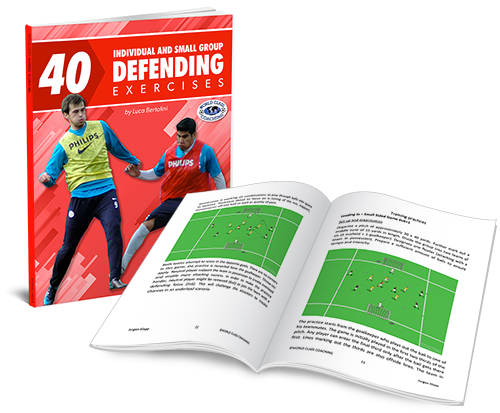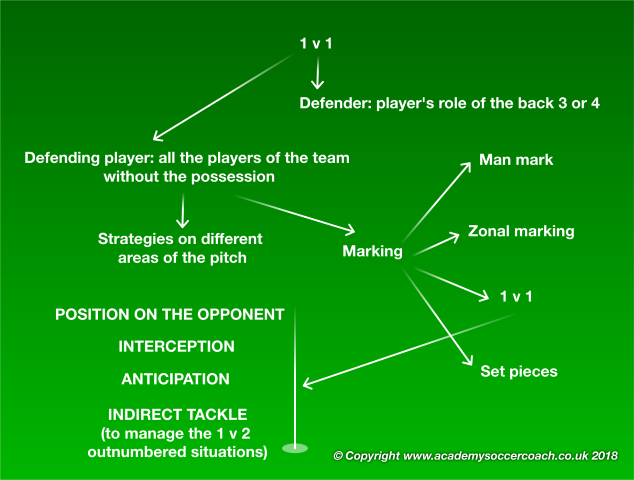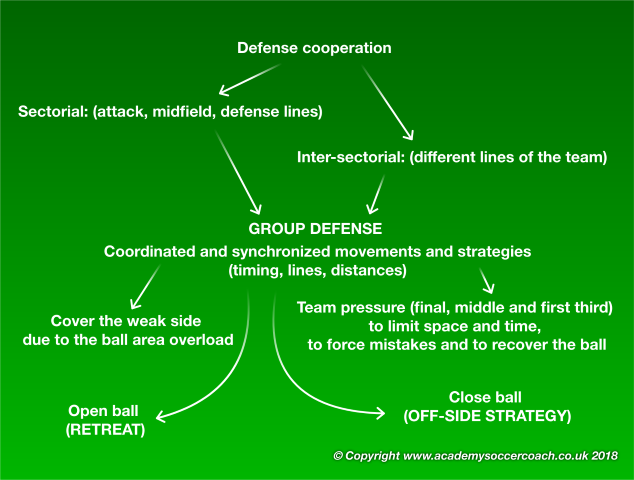WORLD CLASS COACHING
40 Individual Defending and Small Group Exercises
By Luca Bertolini

Table of Contents
PART ONE
Introduction
Defending Roles and Responsibilities
Create Skilled Defensive Players
Create Effective Group and Team Defense
PART TWO
1v1 Exercises
PART THREE
2v2 Exercises
2v2+1 Exercises
PART FOUR
3v3 Exercises
4v4 Exercises
Introduction - Defensive Principles of Play
Soccer is a continuous sequence of small-sided games that connect different groups of players together, throughout all the four phases of the game (attacking, defending, transition to attack, and transition to defend); passing and receiving or dribbling the ball, or by moving without the ball into other areas, to receive or to defend.
Soccer is usually broken down into basic tactical principles that players must learn, read and practice on the pitch, to know how to improve their decision-making process and how to play.
The specific tactical principles of the defensive phase should help all players, both near the ball as well as away from it, to coordinate their actions and their tactical-technical behaviors within the team's defensive style, to save the own goal and to regain the possession. These principles should help players to guide their behaviors and positions in relation to the ball, their own goal, their opponents, their teammates and the dynamic events of the match.
The defending principles can be considered as follows: player, sectorial (forwards, midfielders, defenders), inter-sectorial (small-sided space moves near the ball of players involved in different sectors) or collective defensive actions, to create an advantage situation against the attackers, to recover the possession or just to counter them and to stop the opposition possession and attacking phase.
BASIC - PLAYER PRINCIPLES OF PLAY
Positioning: body placement and of the player on the pitch related to the ball position and direction, opponent body placement and goal to defend. We may consider as positioning all the actions that a player carries out during the transitions to defend phases.
Mark: A defender watching over an opponent of the attacking team, with the purpose of reducing the chances of taking part to the attacking move. 1 v 1 duels are related to the ball position and direction, the opponent body placement (in possession or not in possession) and the own goal to defend.
Interception: win the ball by closing the passing lanes, to avoid a forward pass between two players of the opposition team.
Anticipation: prevent the direct opponent from taking advantage while he is approaching the ball but not in possession yet.
Tackling: contact made with the foot during 1 v 1 duels, when the opponent is already in possession with the purpose of preventing the next offensive action or regaining possession.
Goal defense: positioning to cover the goal space and to close the passing lanes toward it, preventing the opposition from finishing.
Press: the individual action of a player who defends with intensity against the opponent already in possession or just after receiving the ball; the most important pressure actions are the 1 v 1 duels against the ball carrier. In general, a defender prevents the player in possession of the ball from playing forward or passing to a teammate and attempts to regain possession of the ball.
Prevent turning: pressure on an opponent who has his back to goal and is attempting to change the direction of the ball towards the attacking zone.
Cover: width and depth coverage by a player who creates a second defensive line in order to make the
support of a teammate easier. For example, a center back behind the central midfielder can help him in case the opponent wins the first duel or an outer midfielder who help the fullback recovering the space behind him if he is overcome.
ADVANCED - TEAM PRINCIPLES OF PLAY
Balance: coordinated movements of the defending team from one part of the field to another, as the ball is moved to that part, keeping the defensive active area (near and around the ball) balanced and paying attention to the weak side (away from the ball). The objective is to reorganize the defense in front of the ball.
Tracking: to follow the runs of the opponents off the ball and of the player in possession when dribbling. For example, a defender chasing an attacking player who is making a forward and/or diagonal movement in front of the ball to generate a passing option.
Switching positions: the exchange of positions between two defenders in order to be more efficient defensively against cut, diagonal runs or overlapping combinations of the opponents. For example, a center back moves to the flank to defend the right-attacker and the left defender runs toward the center to cover the center back position, while retreating.
Zonal Defending: the equal distribution of defenders into space to create defensive efficiency and to prevent the opposition from reaching the goal; every player should be aware of the assigned area of responsibility.
Team pressure: intense, constant and organized actions from a group of players against the opponents to create defending numerical advantage 2 v 1, or more, on the ball, and as unit in the final third, middle third or first third.
Retreat and recovery: movement of a group of players back toward defensive positions in order to reorganize the team’s defensive shape and to avoid the opposition playing in behind the line and at the back of the last defense line, when the pressure action is not effective.
Compactness/Concentration: create high density of players near the ball to force the opposition's possession phase backwards or toward the sidelines.
Direct the opponent: force the direction of the possession phase of the opposition (player, sector or team) toward easier areas to defend; generally outside or inside to create high density of players.
Delay: action of the defending team against the opposition, to decrease the space of the offensive phase, restricting the passing options and avoiding dribbling moves to progress through the field and toward the goal. The rhythm of play must be slowed down.
How the players must exploit and apply these principles of play on the field, depending on the game situation? This following basic diagram helps us to answer the question:

Players defending roles and responsibilities
Goalkeepers
They must be confident, mentally tough, and brave to dominate the penalty area, great communicators to help and direct the defenders first, and all the teammates too. They must be able to anticipate the danger and to call the teammates to the right defending positions. As the roles of modern goalkeeper has developed, and they are fully field players now, they must provide cover all over the first third, when the team is pressing high the pitch or even only because the defense line is placed high. From a technical point of view, they must take up great starting positions to intercept, they must be excellent shot stoppers from long and short range and they must solve aerial situations. As the attacking teams are used to press high as prior defending phase, they must recognize when to catch the ball and when to parry it, to avoid second ball chances for the opposition.
Center Backs
As zonal defending has become a necessary dogma nowadays because of possession and positional play principles, they must know very well when to get tight, when to make space or cover and when to ‘drop off,” when and how to track runners, understanding how to ‘hold the line’ and leave the opponents offside. They must be very careful to understand when to direct the opponent toward his weak foot and when to close him toward the sidelines to save the goal space. They also must be great communicators and help the teammates of the defense lines or of all the other sectors to keep organized and compact. They must be confident and comfortable in 1v1 situations, aggressive and composed in tackling situations, particularly set pieces. They should know how to anticipate the direct opponent, to intercept the ball ahead of the opposition players both on the ground and in the air.
Full Backs
The midfielders are asked to play up the pitch in modern soccer, as well as the wingers are asked to overload the center or to be placed very high and wide. When in possession, full backs are more playmakers rather than covering defenders. For these reasons, when the team loses the possession, they must be excellent at defending in 1v1 situations, as they are often alone. They have to know how and when to show the inside and the outside while facing the opponents and prevent them from crossing by tackling or blocking. It is very important to understand how to defend as part of the back four to cover the center backs; the distances and angles of the defense lines are vital to keep them compact.
Defensive Midfielder
First of all he must ensure lines of the team staying compact thanks to a good aerobic ability to play all over the pitch (first and middle third mainly). He usually has to control the space between the midfield and the defensive blocks to prevent opposition midfielders and forwards from passing in behind and over the defense line, containing and countering any penetration attempt and attack against. He must be good at man marking if the opposition forwards are lost by the center backs (from behind, side or front); depending on the situation he has to replace back players who have advanced forward, filling the space that may appear. He should press, double the mark or tackle when required in the middle third and final third (centrally and wide), as well as support the pressing teammates who need assistance, tracking runners or ball carriers.
Advanced midfielders
They must always be aware that they are the first defenders, when the team loses the possession. They must press with intelligence and determination, with the right angle and speed. They are the first players who have to try to direct the opposition possession phase toward easier areas to defend (sidelines or condensed center areas). They must track the opposition center defenders attempting to step into the midfield, anticipating and intercepting passes. During transitions to defend, if the pressure phase was not successful, they must recover behind the ball.
Wingers
They must be good at recovering, reacting and acting as a first defensive barrier in wide areas, helping the teammates on the flanks and covering the position when the ball is on the opposite side. Wingers must learn how to attack with their man while he’s making runs, with or without the ball, by staying goal side; they must be able to tackle, delay the opposing player, and defend cross passes. It is very important how they counter the opposition building up phase of play, forcing the possession phase where the team prefers to defend.
Forwards
First of all, they have to know how to press, direct, delay and contain the opposition building up phase. Secondly they must come back into defensive side of field to help pick-up cleared or second balls, receiving passes from teammates to make the possession safe; all the midfielders should be able to pass them the ball.
How to build up a defensive skilled player

The bases of a good defensive player are all the individual skills (technical, coordinative and cognitive) that allow to face an opponent to try to overturn a game situation from defense phase into a transition to attack or to manage a transition to defend phase as the possession is lost, to counter the opposition attacking phase, before being involved in the defense phase inside own half of the field; if it's not possible, then a player must be confident with the defense phase.
What is important to consider for a defending player?
• Area of the field
• Opponent
• Game situations (play by play, throw-ins, set-pieces, goalkeeper's kick)

Player's action must be related to:
• Ball position: focus on the ball and on potential trajectories
• Opponents: every player to counter has different technical, tactical and physical characteristics
• Teammates: how to cooperate with a close teammate
• Area of the field: all the players of a team without possession can be considered as defenders (forwards are the first defenders)
• Own goal: the defenders must be placed correctly to force the opposition possession away from the goal
From a technical point of view, the following skills seem to be the most important:
• Tackles, interception and anticipation with right timings, reading space and trajectories
• Headers to send the ball away from dangerous areas and to defend the penalty area
• Acrobatics such as sliding tackles or aerial rebounds to solve dangerous situations
From defenders (player roles of the defense line) the players must develop themselves into defending players (all the players of the team without the ball).

These are the main skills to reach this objective:
• Marking: reduce the space and time for the ball carrier (direct mark) and for the potential receivers to be unmarked (preventive mark)
• Patience: wait for an advantage situation to take action and recover the possession
• Direct the opponent: force the player in possession toward easier areas to defend or to take advantage against him (his weak foot, or defender better skills)
How to create effective group and team defense
What is the defender's behavior according to the different areas of the field? How to work on the strategies in each area of the field? Is it better to code the behavior rules to perform in each zone or to encourage experiences for the players to discover solutions?

All these sectorial and inter-sectorial principles of play create defense cooperation pattern of play and shape the team transition to defend and the defense phases.
Group defense means coordinated and synchronized movements and strategies related to timing, lines, and players’ distances of the defending team.

Cover the weak side:
• Prevention on the weak side due to the density near the ball area
• Sectorial and inter-sectorial organization and cooperation
• Synchronization of movements and timing related to the offside strategy
Pressure:
• Inside the first third in case of outnumbered situations
• Inside the middle third to look for counter-attacks chances
• Inside the final third to counter the build-up phase of play of the opposition
When to press?
• Wrong ball control of the opponent
• Wrong body position of the opponent on the ball or of a potential receiver
• Wrong pass
• Wandering aerial balls
• Throw-ins
Offside strategy situations:
• Outnumbered defense situation
• "Easy reading" situation
• Goalkeeper, defense and midfield synchronization
• Zonal defending
• Player characteristics
The principles of play of the offside or retreat strategies:

Note - for the exercises: transitions (to attack and to defend) are understood every time the possession is won or lost.


